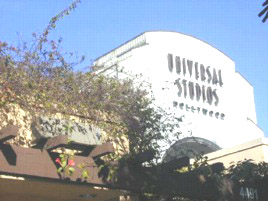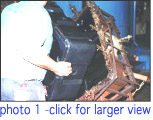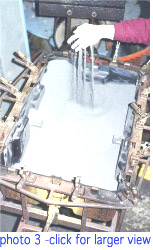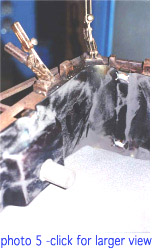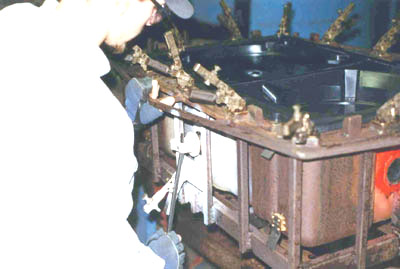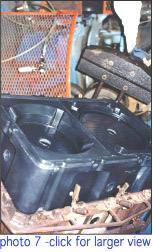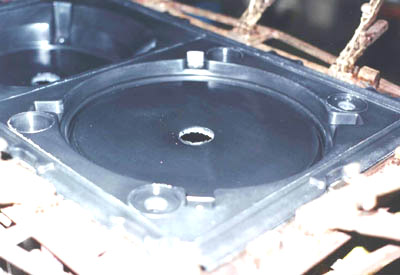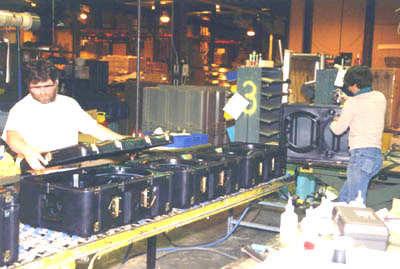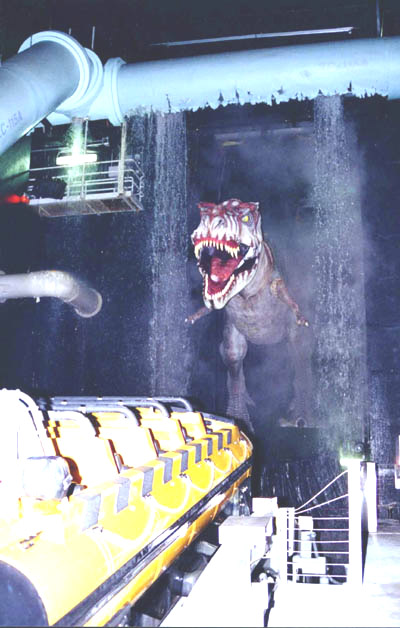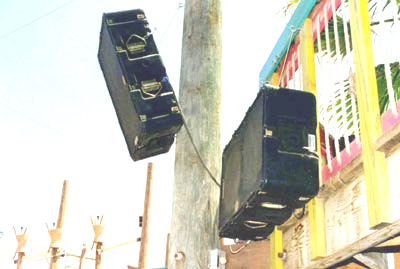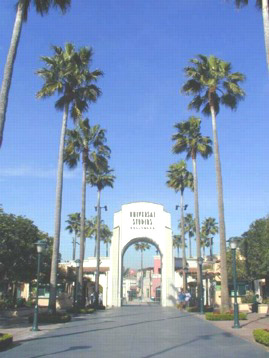 Technomad Paris 616T loudspeakers have been installed at the main entrance gate of Universal Studios, Hollywood. Universal ordered these Paris 616 Loudspeakers in “Desert Sand” color, allowing the loudspeakers to blend inconspicuously into the foliage and woodwork on top of the ticket booths. The Technomad loudspeakers play a mixture of music and voice, playing a greeting message to visitors and extolling the delights that await them within the Universal Park. The Paris 616T units are equipped with a 70-volt internal transformer, tapped at 128-Watts. The Paris 616, like all of the compact MP-Series Technomads, features a 1″ horn-loaded ceramic high frequency driver for outstanding music projection and voice intelligibility, as well as high-excursion poly-cone bass drivers. Of course, the Paris is fully weatherproof due to its three-layer stainless steel WeatherTech™ grill, Military-specification rotationally molded cabinet and self-draining construction.
Technomad Paris 616T loudspeakers have been installed at the main entrance gate of Universal Studios, Hollywood. Universal ordered these Paris 616 Loudspeakers in “Desert Sand” color, allowing the loudspeakers to blend inconspicuously into the foliage and woodwork on top of the ticket booths. The Technomad loudspeakers play a mixture of music and voice, playing a greeting message to visitors and extolling the delights that await them within the Universal Park. The Paris 616T units are equipped with a 70-volt internal transformer, tapped at 128-Watts. The Paris 616, like all of the compact MP-Series Technomads, features a 1″ horn-loaded ceramic high frequency driver for outstanding music projection and voice intelligibility, as well as high-excursion poly-cone bass drivers. Of course, the Paris is fully weatherproof due to its three-layer stainless steel WeatherTech™ grill, Military-specification rotationally molded cabinet and self-draining construction.
See Paris 616 Information
Category: Articles
Thanks for visiting the Articles area. To see how other people are using Technomad products, scroll down, or select one of the many articles on the sidebar at the right.
>> For Product information click here.
Technomad Goes Ape: A Classic Theme Park Attraction Revisited.
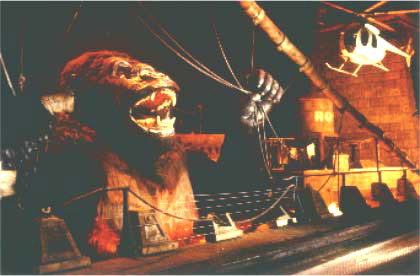 You suddenly hear multiple sirens around the next corner as emergency vehicles race to a yet unseen calamity. A rapid pulsation in the air signals nearby helicopters, getting closer, possibly ready to fly directly overhead. The ground begins to tremble under the feet of fleeing citizens. Even deeper, resonating ground tremors shatter windows, crack concrete, and cause the elevated train platform to shriek as straining metal supports sway, expand, and contract under the stress of the moving Earth.
You suddenly hear multiple sirens around the next corner as emergency vehicles race to a yet unseen calamity. A rapid pulsation in the air signals nearby helicopters, getting closer, possibly ready to fly directly overhead. The ground begins to tremble under the feet of fleeing citizens. Even deeper, resonating ground tremors shatter windows, crack concrete, and cause the elevated train platform to shriek as straining metal supports sway, expand, and contract under the stress of the moving Earth.
As you pass an apartment building your attention is drawn to an open window and the glow of a television. The volume is set very loud and you listen to a frantic news woman reporting from a hovering news helicopter, apparently, over the site of the turmoil. She warns to, “Stay away, it’s loose… danger…!” In an instant the televised image becomes muddled as the cameras and people in the helicopter are tossed about and the sounds of screams, mixed with twisting metal, pierce the night. The aircraft’s engine, which is clearly heard from the television, as well as from the now overhead helicopter itself, labors against an opposing force, then loses power. All hell breaks loose above the elevated train platform and then you see the news helicopter steak toward the ground, smoke trailing out of its engine compartment. Becoming mercilessly tangled in overhead cables, the speed and weight of the falling craft pulls down several power poles. Sparks from snapping high-tension cables instantly ignites leaking fuel and the helicopter erupts into a ball of flames as it impacts the street, a mere few yards from your vantage point. A car veers to avoid the flaming wreckage, only to lose control and crash into an apartment building, not before taking out a fire hydrant or two.
The sounds of chaos, behind, above, and all around you, become overwhelming. When you turn, you see several cars from the elevated train now lay in twisted heaps on the street, fallen – possibly thrown – from the elevated platform. Smoke emanates from out-of-control fires, fed by ruptured gas lines, as high-pressure steam and water blasts out of innumerable and unseen broken pipes. Your mind races, “Got to get to the Brooklyn Bridge, must get off of Manhattan Island,” as you make your way to perceived safety through a massive cloud of blinding steam and smoke.
Just before you think it could get any worse, it does. The impact of repeated gas-fed explosions hits you in your chest. Gun fire, screaming citizens, and an amplified voice of authority warn of increasing danger. Rapid fire machine gun reports are heard before the muzzle flare is seen through the murkiness of the dissipating steam cloud. The choking heat of the steam in your lungs is quickly blown away by the propeller draft of a low-flying police helicopter. As you regain your vision, you find you have somehow made it onto the Brooklyn Bridge. Before gasping your first breath of cool air, the bridge underneath you shudders, and then the suspended roadway swings wildly. As your eyes focus you find yourself looking directly into the face of the largest ape you have ever seen. King Kong is pulling on the suspension cables of the bridge, jeopardizing not only the structure, but also your only route to safety. The police helicopter’s machine gun fires point blank at the enraged beast. If the bridge structure holds, maybe, just maybe, you can get to the other side before the giant gorilla crushes you or you’re hit by a stray, or ricocheting, bullet. A loud, clear, calm voice breaks through the pandemonium, “Please keep your arms and legs in the tram as it pulls out of the attraction.” Large barn-like doors swing open and you’re back into the daylight as you turn onto Main Street, USA, on the back lot of Universal Studios Hollywood.
The King Kong attraction at Universal Studios Hollywood, installed in 1986, is one of the great, classic attractions in themed entertainment. Not since Jurassic Park went online in June of 1996, has any one attraction become so synonymous with Hollywood, California and Universal Studios. The huge ‘drive-through’ attraction is hidden away in a massive building on the back lot of Universal Studios Hollywood. If the tram didn’t take you through it, you would never know it was there behind all the movie sets and street facades that have played backdrop to countless movies and television programs. The massive diorama of New York City takes up over 45,000 square feet of indoor floor space under 50-plus foot ceilings. The attraction is exacting in its detail, complete with an elevated railway and mangled train, multistory buildings, illuminated city skyline, “flying,” as well as crashing and burning helicopters, gushing fire hydrants, live steam, 30 foot tall natural gas-fed flames, as well as the monstrous, animatronics King Kong himself, pounding a scale Brooklyn Bridge, complete with hydraulically-driven ‘structural failures’. (As one would imagine, the attraction is even replete with New York City-esque graffiti). The gist of the attraction is you, and everyone else on the tram, find yourselves unwilling spectators to Kong’s tirade through New York City. (I believe the story goes, Kong moves to New York City for a girl and a paying club gig, she dumps him as soon as he gets there, the gig involves too many chains and restraints, he finds out he’s getting stiffed on his box-office receipts, he storms off-stage, etc., etc., etc.)
When the King Kong attraction is static, the temperature in the room remains pretty cold, hovering close to the low 60 degree mark in the summer, and significantly lower in the winter months. During evening maintenance hours, workers are usually wearing heavy jackets or long underwear when servicing the attraction.
The King Kong attraction is only 150 seconds in duration, but in that time period, the room atmosphere and climate goes through very drastic changes, providing an additional aspect of realism to the overall show. When the tram enters the attraction and triggers the system to start, multiple plumbs of water and fire shoot up to 30 feet into the air, and boiler-generated steam turns the cold and dry air into a hot and humid atmosphere in 30 to 45 seconds. At the height of the tourist season, the King Kong attraction can be operational 24 times per hour, with as many as 77,000 visitors passing through it in a single day. During the busy holiday and vacation seasons, one tram is exiting the attraction as another is entering.
Harald Emmert, Sound & Video Foreman, points out, “It’s a loud attraction. The designers were very successful in recreating New York City, which is a loud city to begin with, but on top of that they needed to make it sound like it was being torn apart and destroyed by King Kong.” The original sound system consisted of over 40 distributed, mostly bi-amped, loudspeakers and the attraction – at peak operating performance – has an SPL output of 120 dB. The loudspeakers were either flown from the ceiling, positioned around King Kong and the Brooklyn Bridge, or concealed in other elements and building facades.
The King Kong attraction is also a very hostile environment, especially for loudspeakers. Over a period of eleven years, the original sound system hung in the Kong attraction, but not without audio technicians replacing a multitude of 12″ and 15″ cones every six months. “Speaker cone material would simply deteriorate from the conditions,” states Harald, with other AV department technicians concurring. Continuing, Harald points out, “Loudspeakers used for the pyrotechnic and water sound effects were always in close proximity to these effects to create the illusion the fire or water was actually emanating the sound. These were always the loudspeakers that required the most maintenance.”
Harald continues, “We can measure a temperature shift of 20 to 25 degrees or more from when the attraction starts its cycle to when it finishes. The temperature variations at the ceiling level, where approximately a third of the loudspeaker system is installed, are significantly greater than at street level. Temperature shifts of 30 to 35 degrees are not uncommon, even with all the automatic exhaust and venting fans on full blast. But, aside from temperature and atmospheric changes, there is a tremendous amount of dirt and dust in the form of exhaust generated by the gas burners and 15 to 24 diesel-powered trams per hour.” All of the signal processing is hidden away in a sealed, secure, temperature-controlled room, free of drastic temperature changes, dirt, dust and other forms of ‘attraction exhaust’.
Ed Carri, Line Supervisor for the Audio and Video Technology Department, previously held Harald’s position of Sound & Video Foreman, and as a 20 year Universal AV Department veteran as of May 1999, has “seen-it-all.” He and then-Manager of Sound & Video, Jim Schmidt, specified a new Technomad sound system into the King Kong attraction after they found success with the Technomad loudspeakers on Scene 12 of the Jurassic Park attraction. Scene 12 is the climacteric indoor section of America’s largest water-ride, featuring the world-renowned 20 foot tall, animatronics Tyrannosaurus Rex. Ed states, “The mist, moisture, and humidity generated by Scene 12’s three story-tall, 5,000 gallon-per-minute-waterfall, from where T-Rex emerges, is overwhelming. The former sound system could not withstand this environment, and we were left no alternative but to replace it after it succumbed to the elements, for the fifth time, after only four months of operation.”
 Aside from the elements, Scene 12’s background noise from the waterfall, the noise of the boat on the tracks, and the chain-pull mechanism, registers a consistent 100 dB. In October 1996, the original mid/high cabinets were replaced with one pair of evaluation Technomad Berlin loudspeakers, left and right of T-Rex. The results were immediately evident, with the T-Rex roaring sound effect pinning the SPL meter a level of 110 dB, 60 feet from the source. “We were sold,” states Jim.
Aside from the elements, Scene 12’s background noise from the waterfall, the noise of the boat on the tracks, and the chain-pull mechanism, registers a consistent 100 dB. In October 1996, the original mid/high cabinets were replaced with one pair of evaluation Technomad Berlin loudspeakers, left and right of T-Rex. The results were immediately evident, with the T-Rex roaring sound effect pinning the SPL meter a level of 110 dB, 60 feet from the source. “We were sold,” states Jim.
In November 1996, Los Angeles-based Direction Sound/Vision assisted in replacing the Scene 12 sound system with a Crown-powered Technomad sound system, consisting of eight Berlin 15/H two-way loudspeakers and eight Chicago 15/12 subwoofers. The Technomad Chicago subs, powered by two MarcroTech 5000s, are distributed on the platforms, four subs on each side of the boat track, to deliver T-Rex’s ominous, ‘approaching’ footstep sound effects. Eight Technomad Berlin 15/H loudspeakers, powered by Crown Power-Tech 1 and 3 amplifiers, deliver the blood-curdling roar of T-Rex as the beast lunges at the spectators in the final moments of the ride. Two Berlin loudspeakers are installed approximately 25 feet above the boat track and fire directly down on the spectators. Four additional Berlins are, again, positioned within 25 feet of the spectators, left and right of the boat track, two loudspeakers per side, parallel to and in back of the overhead Berlin loudspeakers. The original two Berlins remained suspended two feet in front of the waterfall, positioned left and right of T-Rex, approximately 35 feet above the floor, and approximately 60 feet from the spectators.
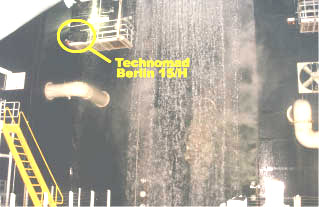 The eight Berlins targeted onto the area where the boat pauses during the T-Rex attack are set to “put 115 to 118 dB on the boat.” Due to a planned waterfall modification four weeks after the two ‘eval-Berlins’ were installed, a newly routed chute began to deliver a daily deluge of water directly onto the two cabinets. “That was the ultimate proving test and they are still working to this day,” states Jim.
The eight Berlins targeted onto the area where the boat pauses during the T-Rex attack are set to “put 115 to 118 dB on the boat.” Due to a planned waterfall modification four weeks after the two ‘eval-Berlins’ were installed, a newly routed chute began to deliver a daily deluge of water directly onto the two cabinets. “That was the ultimate proving test and they are still working to this day,” states Jim.
It wasn’t long after Jurassic Park’s Scene 12 was up and running smoothly that King Kong started to develop a case of laryngitis. Expenses in maintaining the sensitive King Kong sound system had always run considerably above-the-norm. But, when almost 45% of the loudspeakers all seemed to fail within a 60 day period, the executive directive came down to either repair the ailing decade-old Kong system or replace it. Ed states, “Before the theme park undertakes an attraction sound system overhaul of this magnitude, I have to submit several options on how to get it back up to specs. It comes down to, ‘How much for a full replacement system?’, compared to, ‘How much to repair it?’ With both options, you have to deal with replacement component costs, plus attraction down-time, and manpower requirements to complete each scenario, and then it finally comes down to, ‘What’s going to last?'”
Jim Byron, president of Direction Sound/Vision, was again called on to assist in offering up some options on getting King Kong in full voice again. The first alternative was to repair the existing sound system. Jim states, “When I first contacted the manufacturer, I was told the speaker models were so far out of production, they had never heard of the model numbers before. It took them over a week to research the models and get back to me with the news the components were no longer available. I was advised that similar, newer components could be changed out in the cabinets, but based upon specs, the end result would have not met the criteria for the attraction.”
Ed notes, “The difference between replacing 90% of the King Kong sound system with brand new loudspeakers and additional signal chain equipment, compared to repairing the existing system with inferior components, only amounted to about $1,800.00.” Ed continues, “Jim Schmidt and I were already sold on the Technomads after eight months of flawless performance in the drenching conditions of Jurassic Park. It was a dollars and sense agreement at the executive level to upgrade the King Kong sound system with new Technomad loudspeakers, since they were very pleased with the way Jurassic Park’s Scene 12 was sounding and performing.”
Twenty-nine Technomad WeatherTech Berlin 15/H two-way loudspeakers replaced all of the aging bi-amped loudspeakers. Seven Chicago Technomad WeatherTech 15/12 subwoofers replaced the “no-one-knows-how-old” ‘sensurround’ subwoofers that provided the low-end ‘Brooklyn Bridge’ rumbling effects as King Kong shakes the bridge in the final moments of the attraction. Three Technomad WeatherTech Noho/C loudspeakers provide ‘screeching’ effects on the elevated train and gunfire sound effects on the hovering police helicopter.
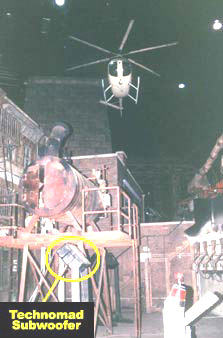 The ‘ground-level’ Brooklyn Bridge Berlins and Chicagos were installed out of sight of the visitors, on six foot-tall, adjustable stanchions, to direct their output at the visitors on the tram. The ‘exploding furnace’ erupts in flames, as four gas jets (right), positioned next to the Brooklyn Bridge, blast flames into the air during the final moments of the attraction. To create a louder, more dynamic explosion and burning sound effect, one Berlin loudspeaker and one Chicago sub is placed in close proximity to these fire effects. Note the Berlin (foreground, below the boiler) and Chicago, (behind the boiler support structure), are both positioned within six feet from where the flames erupt out of the boiler, (noted by the blackened areas on the boiler). Another Berlin and Chicago are positioned, again on stanchions, on the upper ledge (back right), to the left of the four gas jets. A cabinet from the original sound system sits idle, to the immediate left of the four gas jets, waiting to be removed and scrapped. One flown Berlin loudspeaker is visible in the darkness, at 11 o’clock of the helicopter’s propeller blade. Seven of the twenty-nine Berlin Loudspeakers installed in the Kong attraction are positioned in the windows of the apartment building facades, concealed by curtains and window dressings. These two Berlins fire at the Brooklyn Bridge providing sound effects consisting of explosions, panicked citizens, sirens, and ‘bridge rumblings’.
The ‘ground-level’ Brooklyn Bridge Berlins and Chicagos were installed out of sight of the visitors, on six foot-tall, adjustable stanchions, to direct their output at the visitors on the tram. The ‘exploding furnace’ erupts in flames, as four gas jets (right), positioned next to the Brooklyn Bridge, blast flames into the air during the final moments of the attraction. To create a louder, more dynamic explosion and burning sound effect, one Berlin loudspeaker and one Chicago sub is placed in close proximity to these fire effects. Note the Berlin (foreground, below the boiler) and Chicago, (behind the boiler support structure), are both positioned within six feet from where the flames erupt out of the boiler, (noted by the blackened areas on the boiler). Another Berlin and Chicago are positioned, again on stanchions, on the upper ledge (back right), to the left of the four gas jets. A cabinet from the original sound system sits idle, to the immediate left of the four gas jets, waiting to be removed and scrapped. One flown Berlin loudspeaker is visible in the darkness, at 11 o’clock of the helicopter’s propeller blade. Seven of the twenty-nine Berlin Loudspeakers installed in the Kong attraction are positioned in the windows of the apartment building facades, concealed by curtains and window dressings. These two Berlins fire at the Brooklyn Bridge providing sound effects consisting of explosions, panicked citizens, sirens, and ‘bridge rumblings’.
King Kong’s “growl components” consist of one Berlin 15/H, one Chicago 15/12 subwoofer, one Electro-Voice MTH 2/64, and two ElectroVoice MTL2s. Kong’s EV loudspeakers are powered by one Crown MicroTech 600, 2400, and 3600 amps. Harald points out, “The EV loudspeakers were installed about two years ago to augment the existing loudspeaker system. The EV loudspeakers are almost underneath Kong and the mechanism that supports him. They are partially protected from the attraction elements since they are installed underneath the bridge and, at this point in time, they are hanging in there.”
The third Noho was installed in King Kong’s chest to “augment his vocalizations.” Over the course of time, the original speaker that was installed in Kong’s chest was regularly shaken to the point of failure from his movements. Kong is a very large animatronics machine and his movements are quite extreme. Harald states, “We found the Noho to be a very powerful, compact, durable speaker that fit perfectly and could hold together in this extremely ‘mobile’ application. The EV system puts out some really nice SPL levels, but if Kong’s voice is not emanating from King Kong himself, the impact of the attraction’s climax is anticlimactic. The Noho does a good job of cutting through, so it sounds as if Kong is screaming in everyone’s face.”
Six Pioneer LV-D 6000 laser disk players feed the attraction’s entire video and audio program material through six, newly acquired, dBx 2231 EQ’s, and the remaining signal processing gear that consists of one dBx 12x-DS Sub Harmonic Synthesizer, one Urie JBL 5547A EQ, two Urie JBL 5549 EQs, three Urie JBL 5234A crossovers, three IED 5000 VCAs, one Ramsa WS-SP2A Sub Processor, and one Aphex 120 DA.
Most of the Technomad Berlins and all of the Noho/C loudspeakers are driven by the existing BGW 250D amplifiers. “I’m very impressed with the efficiency of the Berlin and Noho loudspeakers,” states Harald. “The majority of the 400 watt, 8 ohm Berlins are seeing as little as 125 Watts into 8 Ohms from the BGW 250Ds, and they are putting out a lot of sound. The 275 watt, 8 ohm Noho is powered with 350 Watts into 8 Ohms from a bridged mono BGW 250D per-speaker, and states Harald, “there is a lot of sound from such a small loudspeaker.” A combination of Berlin loudspeakers and Chicago subwoofers are powered by thirteen BGW 750D amplifiers. Berlins used for articulation-critical, spoken word program material are driven with 250 Watts at 8 Ohms. Seven of the fan-cooled, bridged mono BGW 750Ds pump 1200 Watts into each of the seven 700 watt, 4 ohm Chicago subs. Harald points out, “When we pulled out all of the old bi-amped cabinets, we suddenly found ourselves with a lot of additional amp channels. We’re getting significantly better articulation and detail in the system, with far less power.”
Ed Carri sums up the reliability of the BGW amplifiers with one word; “Excellent.” Expanding on the subject, Ed states, “The late 70s-era BGWs that were installed in the King Kong attraction are all original from when the attraction went online in 1986, and I don’t remember ever experiencing a failure with any of those amps. BGW amps were installed in a very big way through out Universal Studios Hollywood in the 1980s, and many if not all of them are still in service. They are incredible workhorses that just keep getting moved from attraction-to-attraction.”
Robert Dugger replaced Jim Schmidt in early 1998, becoming Manager of Technical Response, when Jim was promoted to Manager of Attraction Engineering. At the same time Harald Emmert was promoted to Sound & Video Foreman when Ed Carri was promoted to Line Supervisor for the Audio and Video Technology Department. The entire Technomad system was installed by the Universal Audio Visual staff, under Ed Carri’s direction, and it was Harald who supervised the rewiring of the entire Kong system. Robert was responsible for final tuning and adjustments to the system, which only took two evenings. Robert points out, “Coming into a new position, you’re always concerned about what the outgoing staff is leaving you, especially if you’re not familiar with the products. Since making final adjustments on the Kong attraction we’re back up to its original SPL specs, and the system remains incredibly stable. We only make finite adjustments to various zones if we get a notice from a tram driver, tour guide, or visitor that a specific zone might be too loud or too low. Those adjustments have been few and far between.”
Robert and Harald agree, if something works, you stick with it. “As loudspeakers in critical outdoor or caustic environments continually die, we replace them with Technomads,” states Robert. Harald concludes, “So far, there are no natural or manmade elements that can stop the Technomads… that we can find. It’s surreal to see the Technomad loudspeakers in waterfalls, continually getting blasted with steam, or in such close proximity to massive, open flames. As an audio professional, seeing a speaker, especially, in a waterfall just goes against what you know loudspeakers can and cannot do. The amazing thing is, the Technomads do it all and more. No matter what we throw at these things, they just keep working.”
—–
Primary King Kong system: 6 Pioneer LV-D 6000 laser disk players 6dBx 2231 EQ’s 1dBx 12x-DS Sub harmonic Synthesizer 1 Urie JBL 5547A EQ’s 2 Urie JBL 5549 EQ 3 Urie JBL 5234A crossovers 3 IED 5000 VCA’s 1 Ramsa WS-SP2A Sub processor 1 Aphex 120 DA 16 BGW 250D Amplifier 13 BGW 750D Amplifier 29 Technomad WeatherTech Berlin 15/H two-way Install Version Loudspeakers 7 Technomad WeatherTech Chicago 15/12 Install Version Subwoofers 3 Technomad WeatherTech Noho/C two-way coaxial Install Version Loudspeakers
King Kong ‘Growl’ components:
1 EV MTH 2/64 2 EV MTL 2 1 Deltamax controller 1 EV Crossover 1 Crown Microtech 600 Amplifier 1 Crown Microtech 2400 Amplifier 1 Crown Microtech 3600 Amplifier
Technomad at the Canada Games Pool Complex
» More Information on Weatherproof Audio Systems
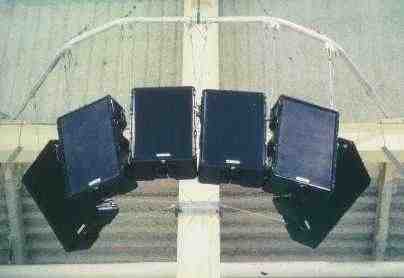 The Canada Games Complex is a very well-known fitness facility in Thunder Bay, Ontario, Canada. It is used by over 1,000 people per day, in an area that has a population of only approximately 175,000. “Needless to say,” notes Nat/Com’s Brad Oja, “it’s a popular place.
The Canada Games Complex is a very well-known fitness facility in Thunder Bay, Ontario, Canada. It is used by over 1,000 people per day, in an area that has a population of only approximately 175,000. “Needless to say,” notes Nat/Com’s Brad Oja, “it’s a popular place.
” The original sound system in this room was installed when the building was constructed in 1981. Every two years – “like clockwork” – the system had to be completely rebuilt with all new drivers, diaphragms and other vital hardware. The corrosion that developed on the former sound system over short periods of time gradually reduced the system to complete uselessness. The system had to be shut down for a week while it was rebuilt. It was simply getting too expensive to maintain. It got to the point that the cost to maintain the system greatly outweighed the expense of installing a new system that was designed to endure and last in the harsh pool environment.
Mr. Oja was assisted on this project by Wayne Faulconer of W.F. Com. Spec, of Thunder Bay, Canada. Mr. Faulconer states, “To give you an indication of how caustic this atmosphere is to audio equipment, I recently went to remove the mic jacks from the back of a mixing console. The screwdriver went through the console’s metal plate, leaving the XLRs dangling in mid-air, only attached to their wires.” Wayne continues, “The manager of the Canada Games Complex is a far-sighted guy who wanted to invest in a new sound system with a long life cycle. Plus, it was apparent he was tired of being the target for all of the flack whenever the system crashed or if the sound was inaudible during special events.”
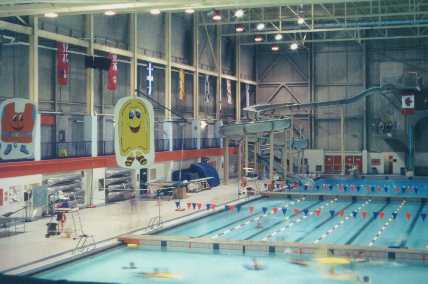 Essentially, Nat/Com “took a gamble by spacing Technomad” into the Canada Games Complex project. Brad is quick to point out, that neither he, nor the customer, had ever heard of Technomad loudspeakers prior to the quoting on the installation. Both Brad and Wayne felt it necessary to position Nat/Com apart from the competition and provide a speaker system that was going to hold up to the elements, chemicals, and humidity. Wayne suggested Nat/Com should investigate Technomad loudspeaker products, based upon Technomad’s “extraordinary claims” of ‘built to military specifications’ and their resistance to withstand weather, water and chemicals. The fact that Technomad WeatherTech loudspeakers are Mil-Spec, and are designed for ‘caustic’ applications convinced Brad and Wayne they found the right speaker for their customer’s needs. Brad states, “We needed it to set us apart in order to get the job, and, overall, I would have to say, Technomad closed the deal for us.”
Essentially, Nat/Com “took a gamble by spacing Technomad” into the Canada Games Complex project. Brad is quick to point out, that neither he, nor the customer, had ever heard of Technomad loudspeakers prior to the quoting on the installation. Both Brad and Wayne felt it necessary to position Nat/Com apart from the competition and provide a speaker system that was going to hold up to the elements, chemicals, and humidity. Wayne suggested Nat/Com should investigate Technomad loudspeaker products, based upon Technomad’s “extraordinary claims” of ‘built to military specifications’ and their resistance to withstand weather, water and chemicals. The fact that Technomad WeatherTech loudspeakers are Mil-Spec, and are designed for ‘caustic’ applications convinced Brad and Wayne they found the right speaker for their customer’s needs. Brad states, “We needed it to set us apart in order to get the job, and, overall, I would have to say, Technomad closed the deal for us.”
Wayne states, “We contacted Technomad’s sales manager regarding our need for eight Berlin 15/H loudspeakers, based upon the physical specs of the room. Technomad was adamant about talking us out of eight loudspeakers, stating, for sure, we only needed six Berlin 15/H loudspeakers. We thought they were crazy, talking us out of buying the loudspeakers we were convinced we needed. But they was right, and we’re grateful to them for not permitting us to waste additional money on gear we clearly did not need.
Brad continues, “We were very impressed with the specs on paper, and I have to say, the products more then lived up to, and exceeded our, and our customer’s, needs. We tested each speaker on the pool deck before we rigged them for the array, and I have to say, they really blew us away. Technomad was definitely the right choice for this installation.”
Wayne states, “What excites me is the way the Technomads are EQ-ed and the ability to order them with specific, customized EQ settings for specific environments. Otherwise they can be ordered with the adjustable on-board ‘EQ’, known as the Passive Processor.
Technomad loudspeakers are offered with a unique five position, internal Passive Processor¥ EQ System. The Passive Processor significantly reduces or eliminates the need for outboard EQ, thereby reducing expense and system complexity. The EQ contour of a Technomad full-range loudspeaker is ‘shaped’ by the Passive Processor, allowing the operator to compensate for nominal listening distance, atmospheric absorption, and other conditions with a simple, on-loudspeaker adjustment.
Brad states, “The competition came in with literally the exact same system design as a replacement to the existing system. The only difference was, they suggested a few ‘flown’ bass bins to augment the lack of low-end the previous system always suffered from.”
When the management of the Canada Games Complex really started to get into the nitty-gritty of the various proposed systems, the first question asked was, ‘Will your sound system stand up to the elements in this indoor pool environment?’ Every single engineering department of every manufacturer solicited stated the same single word answer; ‘No.’ Brad humorously notes, “That’s the problem with engineers, they have some ingrained gene that forces them to tell the truth… which in this case was good for Nat/Com and Technomad. We had not doubt the Technomads would go the distance.
The pool room of the Canada Games Complex is huge, with 65 foot tall ceilings and the array is suspended at 45 feet about the pool deck. Wayne notes, “No expense was spared in doing this job right. Every bit of arraying hardware, from the cables, to the nuts and bolts is all stainless steel to assure the system is going to last, and the custom made D-ring support bar is aluminum.” In the arraying of the Technomad system, an elaborate, multi-level truss system needs to be constructed over five days. The installation would have taken 50% less time if a lift truck could have been brought out onto the pool deck, but it was quickly determined that the weight of the lift truck would damage, if not destroy, the fragile tiles of the 15 foot wide pool deck.
The three amps that drive the Technomad Berlin loudspeakers are Crest S-1500s. Outboard processing consists of a Biamp 31 band EQ, a Sony DMX Digital Music Source, and a Biamp 8 Channel Mixing console. A five disc Sony CD player was added to the system as the background music source. Nat/Com also added a KDM Mini Remote Mixer for events that require mixing from remote locations through-out the facility. Microphones are all Rauland 1295 desk-top mics, and a Shure LX Series Wireless microphone system remains from the previous system. A telephone interface paging system was added and microphones are positioned in key locations throughout the building. Eight microphone jacks are located around the pool area, so, depending upon the event, commentators can be positioned in key viewing and announcing locations.
The new Technomad system is used for primarily voice and paging applications, but when major swimming events are held in this pool, the system is called on to deliver a serious amount of power and fidelity. Wayne states, “Everything from paging to music is crisp and clear and the intelligibility is great. The fidelity is so nice, and because the Technomad system is so well-damped, reverberation in the room has been greatly reduced.”
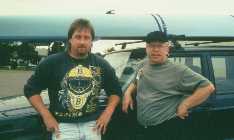 Brad notes, “We really scared the hell out of a lot of people with the new Technomad system. Everyone who works at the facility was very used to ‘eating’ the mic when making an announcement in order to be heard. When you’re used to eating the mic for years, and you immediately start screaming into the system in order to compensate for its shortcomings, it’s a hard habit to break. People forget there is a new sound system and they are blown across the room if they approach the microphone screaming an announcement. We are still getting a lot of startled looks from people who thought they were going to get the same weak output as before, and then they are stunned by the new found power, clarity and articulation from the Technomads. Wayne concludes, “In Canada, we have some really harsh weather conditions and a lot of various harsh indoor environments from pools to ice rinks. I cannot suggest a better speaker then Technomad WeatherTechs for these types of applications.”
Brad notes, “We really scared the hell out of a lot of people with the new Technomad system. Everyone who works at the facility was very used to ‘eating’ the mic when making an announcement in order to be heard. When you’re used to eating the mic for years, and you immediately start screaming into the system in order to compensate for its shortcomings, it’s a hard habit to break. People forget there is a new sound system and they are blown across the room if they approach the microphone screaming an announcement. We are still getting a lot of startled looks from people who thought they were going to get the same weak output as before, and then they are stunned by the new found power, clarity and articulation from the Technomads. Wayne concludes, “In Canada, we have some really harsh weather conditions and a lot of various harsh indoor environments from pools to ice rinks. I cannot suggest a better speaker then Technomad WeatherTechs for these types of applications.”
For additional Nat/Com info, contact: Nat/Com Communications, Brad Oja, 241 County Blvd., Thunder Bay, Ontario P7A 7M8 Canada. Tel: (807)767-3384, fax: (807)767-3384. Email: natcom@mail.tbaytel.net
Music On The Move Incorporates Technomad Loudspeakers For Awesome Sound, Incredible Bass And Happy Customers.
– By Mark Mikowski
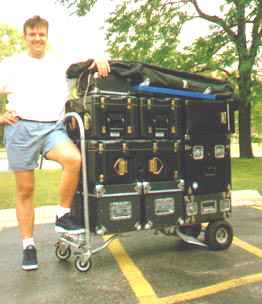 PARK RIDGE, ILLINOIS – Being a DJ/Emcee is not always an easy job. I always inform my staff DJ’s that you have to be prepared for emergency situations, tight set up spots, angry banquet hall owners, uncomfortable set up conditions, and – of course – demanding clients. To sum it all up, you have to be prepared to battle with constantly changing environments, time constraints, and the ability to be your best.
PARK RIDGE, ILLINOIS – Being a DJ/Emcee is not always an easy job. I always inform my staff DJ’s that you have to be prepared for emergency situations, tight set up spots, angry banquet hall owners, uncomfortable set up conditions, and – of course – demanding clients. To sum it all up, you have to be prepared to battle with constantly changing environments, time constraints, and the ability to be your best.
Since I have incorporated the Technomad Loudspeakers to my mobile music systems, I have experienced extremely positive results, along with a whole new world of flexible options when battling with never ending DJ service obstacles.
As a professional in the DJ/Entertainment Industry, I want to tell you that your Technomad loudspeakers are ABSOLUTELY INCREDIBLE. For my operation, Technomad Loudspeakers allow me to have the following:
- Tremendous flexibility for all types of Venues and Events from Weddings to Backyard Barbecues.
- Crystal clean sound quality everywhere I go. Accurate sonic performance from a whisper to a roaring scream.
- Incredible power handling for a very compact system
- Total Weather proofing. No matter what conditions (Indoor, outdoor, rain, shine, humid heat, or below freezing Chicago winters), they’re ready to crank!
- Sleek, Clean and Strong Presentation.
- Easy and secure stack ability.
- Creative Speaker placements.
Another very interesting feature that the Technomads have brought back is a revived, new sense of excitement for Showtime. Lately, I’ve really been looking forward to making all my events sound the best that they can. This, in my opinion, only leads to a clientele base that appreciates the fitness and integrity of my operation.
When 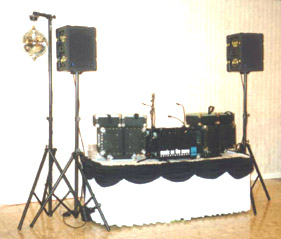 going out in the field to do your best, it’s all about looking great, feeling great, and having a positive attitude that everyone notices no matter if they are young or old. I’m proud to say that Technomad Loudspeakers are a big part of the look good/feel good attitude that I bring to my Job. I will without doubt recommend the Technomads to all my associates and DJ’s that I deal with.
going out in the field to do your best, it’s all about looking great, feeling great, and having a positive attitude that everyone notices no matter if they are young or old. I’m proud to say that Technomad Loudspeakers are a big part of the look good/feel good attitude that I bring to my Job. I will without doubt recommend the Technomads to all my associates and DJ’s that I deal with.
To sum it all up, to me, having Technomads at my side during performance assures me that I’m always giving my clients the Best. (Now all I have to do is trade-in my Van for a Black Hummer.)
Enclosed are several pictures from Music on the Move that I believe you will find interesting. These are pictures from a gig and all my gear gig gear loaded on a cart. Two Technomad Noho/C full-range loudspeakers stack securely on top of the Technomad Chicago 15/12 Sub. Along with myrecord cases, amp and equipment racks, everything rolls in on my Magliner cart in one easy trip. Regarding the gig picture, you are all probably wondering, ‘Where’s the Chicago 15/12 Sub?’ Well it’s under the table. It’s a totally hip,stealthy trick that I thought of to totally confuse people. I get constant complements on my sound. I would like to thank John Flaws of Windy City Music, in Glenview, Illinois, for their support and for introducing me to Technomad loudspeakers.
Mark Mikowski is the president of Music on the Move. Contact Mark at 1460 Renaissance Drive, Suite 101, Park Ridge, IL 60068. Tel: 847-699-3030.
Technomad Articles : How Technomad Loudspeakers are Made
» See Also: Why are Technomad Loudspeakers So Weatherproof? (click to read)
The featured element of Technomad’s trade show display is a simple demo video (click here to view), which despite its unassuming production values manages to stop most jaded trade show attendees in their tracks. In the short film the viewer witnesses a Technomad loudspeaker thrown into a river from a 50 foot bridge, shot with six shotgun blasts, and then finally lit aflame after being doused with half a gallon of gasoline. The video display is flanked by a large lexan tank, in which 300 gallons of water pours over a Technomad loudspeaker each hour. Water sprays from the front grill of the speaker, blasted into the air by the well-tuned LF energy radiating form the driver cone and cabinet ports.
Technomad builds their loudspeakers to endure some of the most hostile audio applications imaginable, regardless if they are permanent, semi-permanent or mobile, indoors or out. Granted, getting thrown fifty feet off a bridge into a river, lit aflame with a half a gallon of gas or shot with a shotgun (all demonstrated in the demo video), is a little extreme for even the most abusive sound rental companies. Most loudspeakers will never be subjected to such a fate on any gig, or while hanging in an array 30 feet above a ball field. But, these tests are a great example of the durability of the Technomad loudspeaker cabinet, its construction and the components contained therein. And they keep on playing, sounding great all the while.
How does a Technomad cabinet withstand such abuse? What on Earth is the Technomad loudspeaker cabinet made of, and what goes into it, that it can endure such torture?
The answer comes from a unique flight case manufacturing technology called roto-molding that was developed and first put into service in 1954.
Since that time, this case and cabinet technology has been in active service in all branches of the US military, as well as in the broadcast, audio, medical, computer, and other industries. The roto-molding process produces a very lightweight, incredibly durable and almost indestructible, one-piece military specification, ATA rated shell. This shell is impervious to water, sand, salt, temperature, mold, mildew, condensation, chemical, insect, UV radiation, acids and other damage.
The electronics contained therein are obviously protected by the cabinet, but they are also specifically designed to withstand the aforementioned elements on their own. Additional protection is assured when the watertight, gasketed lid is attached to the front of the cabinet, and the speaker transforms into an ATA III rated flight case. With the lid attached, the cabinet can be locked together for truck transport, individually shipped by FEDEX or UPS, or checked as airline baggage. The lid also offers great off-season protection for loudspeakers permanently installed outdoors. Instead of taking the whole loudspeaker down if a hurricane is coming, one can simple attach the gasketed lid (and head for the hills!).
Injection Molding and Rotomolding: The Differences
The majority of all plastic loudspeakers are manufactured by injection molding. Injection molding is a process where very hot plastic is quickly squeezed in between an outer and inner mold. The plastic is then rapidly cooled. Any time plastic is quickly cooled stress concentrations can occur, particularly at the corners or edges of the object or around detailed features. Air bubbles can also form in this process of molding and these bubbles can cause areas of weakness that can easily crack or break under stress. These problems are mainly found in very poor quality, low-grade molding processes, where the ultimate goal is to produce large quantities of extremely inexpensive finished products.
Injection molding only allows for cabinet wall thicknesses of 1/8 inch to 1/4 inch. Therefore, intricate ribbing has to be designed into the injection molded cabinet sections to provide strength and rigidity to what would otherwise be a flimsy, highly resonant, finished product (as in the case of a loudspeaker cabinet section). Due to the nature of the injection molding process, it is very difficult to produce large injection molded objects with thick walls. Therefore, all injection molded loudspeakers are molded in multiple sections, and then screwed or otherwise fastened together to create the final, finished product. Injection molded products are produced faster, but they are not as strong as a roto molded product.
Injection molding is how low cost, high volume plastic objects such as disposable cutlery and garbage cans are often made. (Now you know why those cheap plastic picnic forks always snap when you stick them in your Cole slaw on summer holidays). A Technomad staff member, performing a little corporate espionage, once called the technical department of a very large, well-known, competing loudspeaker company. When the technician was asked by the incognito Technomad employee, “how are your plastic loudspeakers produced?”, the unwitting technician, probably new to the position, simply answered, “Just like plastic garbage cans, but only better. ” (We would hope so!)
Because rotomolding is a very time consuming process, taking about one hour to produce one Technomad loudspeaker cabinet, the process allows the finished, one-piece polyethylene shell to fully anneal. The rotomolding process produces 1/2 inch thick linear cabinet walls and 3/4 inch thick corners that are free of imperfections, such as air bubbles, stress areas and other ‘built-in’ weaknesses that are common in other plastic loudspeaker products. This makes for a very strong cabinet, especially in the corner areas where impact is likely to occur. The corrugation that is designed into the cabinet walls provides incredible rigidity to the entire cabinet structure, without the need for additional internal cross-bracing, supports or structure.
The finished Technomad speaker cabinet offers acoustic performance comparable to the very finest 18-ply Baltic or Finland birch cabinets, but without the defects, gaps and sensitivity to moisture and rot inherent in such materials. Because a Technomad loudspeaker cabinet is a one piece shell and has no joints or seams joining multiple parts, the cabinet is completely free of anomalies that plague wooden and, especially, injection molded plastic loudspeakers. This unique, patented cabinet design allows a Technomad loudspeaker to produce a full, articulate sound, without distortion and/or inefficiency problems due to wall flex, vibration, imperfections in Thiele tuning, etc. , that are commonly found in less or quality loudspeakers, regardless if they are manufactured of plastic or wood. Technomad is so confident in its cabinets (and after 43 years of active military service and subsequent military specification approvals, one would assume so), it backs the cabinets with a ten year unconditional warranty.
The Manufacturing Process
Technomad’s rotomolding techniques are extremely sophisticated, and of course, proprietary. Basic rotomolding is relatively easy, but rotomolding a precision loudspeaker is enormously difficult and extremely expensive.
The roto-molding machines that produce the cabinets are fairly massive, complex and expensive. Imagine, if you will, a three blade windmill lying on its back. At the end of each ‘blade’, herein referred to as ‘arms’, are one to four molds, depending upon size and complexity.
Rotomolding is a three-stage process. One arm holds the mold from where finished product is unloaded after it has been through the oven and cooling chamber. Refer to photo #1, the worker removing the finished Technomad cabinet from the mold. When the finished product is removed, the mold is then ready for more poly ethylene powder to produce a new product. Refer to Photo # 2, empty mold. Point of interest: raw polyethylene isn’t a gel or a liquid, it’s a flour-like powder when put into the mold. Refer to Photo #3, open mold containing the polyethylene powder. This polyethylene powder is referred to as a ‘charge’. Unlike other roto-molded loudspeakers, Technomad does not ‘cut’ their polyethylene charge with foam. Foam ‘cutting’ polyethylene decreases cabinet weight and mass and produces a weaker, highly resonant cabinet.
When one mold is being charged (loaded with plastic), another arm simultaneously has as many as four, fully-charged molds in the natural gas-fired oven. The ovens are as wide as twenty feet across, twenty feet deep and twenty feet tall. The larger the oven, the larger the mold that can be accommodated therein. The molds rotate around slowly, for as long as twenty five minutes, on all three axes’, via a complex motor system and gear mechanism. Complete three axis rotation ensures uniform distribution of plastic material through-out the mold as it melts at 600°. The third arm and its molds, having just been in the oven, have simultaneously moved into the cooling chamber, which is as large as the oven, for 25 minutes. In the cooling process, the molds are first cooled with a water shower and then they are air cooled. After all three arms have completed each stage of the cycle; they all simultaneously rotate to the next stage. This production cycle can continue indefinitely, and often times, production continues 24 hours per day.
Technomad LLP believes they are the only professional loudspeaker manufacturer in the world building a line of professional loudspeaker cabinets made entirely of recycled materials. Manufacturing and cabinet design advances allows Technomad to utilize 90 percent post-industrial and 10 percent post-consumer plastics in the manufacture of their black loudspeaker cabinet moldings. Technomad loudspeakers are also available in a wide variety of colors, 13 aside from standard black. Technomad cabinets are not merely finished in colors, but the colors are molded through the cabinet using dyes free of heavy-metals. A Technomad loudspeaker cabinet color – as well as the cabinet itself -wills never fade or breakdown due to chemicals, chlorine, bromine, UV radiation, etc.
All roto-molded cabinets come out of the mold as a complete, one-piece shell. The polyethylene powder, as it melts, builds up everywhere in the mold, even where none is needed, such as where drivers will eventually be mounted. These unnecessary areas of plastic material are later cut out. Speaker horns, driver and mounting hardware cavities, ports, handle and latch hardware anchors, stand mount sockets, etc., are molded into the Technomad cabinet via precision machined, modular tool elements. These elements are ‘swappable’ allowing Technomad to produce several cabinet designs from the same basic ‘shell’ tool, thus reducing production costs. Refer to photo #4, the lid of a Chicago subwoofer and/or Cairo full-range speaker cabinet mold. Note the precision machining of this element. The two circular areas create the indentations for the 12″ and15″ drivers in the cabinet, and smaller circular elements create ports, recessed potentiometer cavities, etc.
The molds are constantly being subjected to extreme temperatures that vary from 600° (315 C) while in the oven, to 60° (15 C), when it goes into the cooling chamber. The low maintenance, single cavity molds are stamped and machined from aluminum and steel for long tool-life.
Refer to photo #5, the removable stand mount socket mold-element is in the lower left corner of interior mold element (slightly blurred), and the ‘butterfly’ latch anchors are to the upper right, interior corner of the mold. To ensure the correct placement of stainless steel cabinet hardware, butterfly anchors, and T-nut fly points (not shown), are secured in place during the molding process on small precision pins and extremely strong magnets. Loudspeaker cabinet hardware anchors and/or T-nuts are put into the mold just prior to the plastic powder during the charging stage. These inserts are extremely strong due to their imbedded construction. The pull-strength of a molded-in T-Nut fly point is rated at four hundred pounds per point, and the small, low-profile, recessed lid latches are ATA-III rated and meet Mil-Spec 810E for security, durability and long life.
Anywhere a hole in the cabinet is desired, such as a port, driver area, etc., a knife edge is designed into the mold element. This knife edge prevents significant build-up of plastic, allowing an unwanted plastic area to be removed with a sharp blow from a hammer while the mold is still warm. Refer to photo #8, close-up of the sharp-edged circle, surrounding 15″ driver placement area. Note the round area within the circle has yet to be removed. This recessed area is where the 15″ driver will be front-loaded into the cabinet. The unwanted piece of plastic will then be ground up and recycled. No additional machining is required of the finished cabinet once it comes out of the mold.
It is also possible to control how thick or thin a particular part of the molding will be by heat shielding that portion of the mold. The less heat a section of the mold receives will produce a thinner wall section in that area, such as the areas where the drivers will be mounted. This allows for easy removal of unwanted areas, and reduces waste. These waste parts are then ground up into powder and then used again in the manufacturing process. Essentially, no plastic waste is ever produced in the manufacturing process of a Technomad loudspeaker cabinet. All by-products are continually recycled.
Roto-molded objects cannot be formed with features which protrude into the finished molded product. Unless, of course, that portion of the mold is removable, such as the stand mount sockets that are molded into each side of the Technomad Berlin, Chicago, Noho, Cairo and Soho cabinets. Again, refer to photo #5. The stand mount socket inserts are pulled out of the mold at the end of the cycle (refer to Photo #6), to allow the finished cabinet to be removed from the mold. Refer to photo #7, the Chicago cabinet halfway out of the mold. Note the stand mount sockets on the two sides of the cabinet.
Cool Cabinets, Man. . . .
After the Technomad cabinets have cooled, they are then sent to mechanical assembly, where, depending upon the model or configuration
ordered by the customer, D-ring fly points, hardware, handles, etc., are attached. Refer to photo #9, the assembly line. Crossovers and filter networks are all front-loaded through the large 12″ and15″ openings, where the drivers will eventually be mounted. These internal components are specially designed to be 100% weather-proofs. Literally, water, sand, salt, mold, etc., has no effect on any a Technomad’s crossover network or the internal Passive Processor™ filter network. The unique contoured design of these finished internal components glove-match to the interior contours of the cabinets and lock into place. This exacting fit assures no amount of shock will ever knock these components loose. Internal tuning is completed with precision-density, weather-resistant polyurethane foam, as opposed to the more typical pink fiberglass insulation.
Customized cast frame bass and coaxial drivers start out with paper cones, but after Technomad’s proprietary three-step chemical process is applied, the driver material more resembles plastic then paper. Technomad’s unique chemical treatment assures the cones will not absorb or be effected by water or moisture. The driver material will maintain the proper balance and mass to provide accurate audio in all environments. Regardless if the climate is thick with humidity and rain, freezing cold or severely dry in blazing hot desert conditions, a Technomad loudspeaker will always deliver uniform and consistent sound quality. Technomad’s chemical process also extends the lifespan of the driver itself in extremely hot and dry conditions by preventing the cone material from drying out, weakening and cracking in short periods of time. Water, should it get on the drivers, simply sheds away, like water beading and running off a freshly waxed car.
The last step of assembly is the three-layer, acoustically-transparent WeatherTech™ grill system. The WeatherTech grill, with its tight perforation pattern and inner layers of mesh and foam, breaks down and sheds away the most tenacious wind driven rain or water. These incredibly fine mesh and foam inner layers also prevent insects, rain, sand and even the finest dust from entering the cabinet. The precision-density, internal polyurethane foam also acts as a massive filter that collects extremely fine dust that might get past the three-layer grill system. Highly destructive dust is prevented from adversely affecting the voice coils and diaphragms.
Where Technomads eventually live:
A During recent inspection of a 22 Technomad speaker installation at a popular seaside resort, photo #10, in Ensenada, Mexico, several Cairo loudspeakers were opened to evaluate the effects of the elements on the system. The loudspeakers inspected had been installed, fully exposed to the direct Pacific Ocean winds, sun, spray, sand and dust, four full months prior. When the grill was removed, the cabinet and drivers appeared as if they had just come from the factory. While there was a excessive amount of dust built up over the port area on the external grill, refer to lighter area on the speaker grill in photo #10, upon removing several drivers and examining the cabinet interiors, no dust was found in the cabinet. The dust build-up on the grill was easily wiped away with a wet rag. Maintenance staff at this facility are simply instructed to place the lids on the Technomads prior to hosing the dust off of them at closing, or just prior to opening.
perfect example of another harsh installation can be seen in photo #11 (Close-up and distant shot, respectively). This is one of the 14 Technomads installed in scene 12 of Jurassic Park, at Universal Studios Hollywood. This pictured loudspeaker, along with the others in the system, were installed in October 1996, after the original ‘weather-resistant’ sound system succumbed to the environment only four months after the attraction first opened in June 1996. Two of the Berlin loudspeakers have continually hung in the waterfall, where five thousand (5,000) gallons of water is re-circulated over, or around them, 12 to 16 hours per day, for 363 days per year. (Universal Studios Hollywood is closed on Christmas and Thanksgiving). That figures out to approximately 4,200,000 million gallons of water on a daily basis, and over 1,500,000,000 gallons annually. (One BILLION, Five hundred MILLION gallons of water). Ed Carri, Manager of Sound and Video simply report, “We have never experienced any problems with our Technomads, ever. They just continually work and sound great.
Not just for Outdoor Use
Technomads are the obvious choice for outdoor environments, but their unique design offers many acoustic advantages as well. The thick and rigid rotationally molded shell offers outstanding acoustic properties, notably in delivering deep, accurate bass without cabinet anomalies. Technomad’s “performance at all costs” approach extends to its highly customized LF drivers and the use of horn-loaded ceramic and compression drivers on all of its models, from the tiny Vernal up to the mighty Berlin. The result is that many demanding clients choose Technomad loudspeakers for critical INDOOR applications such as theater installs, restaurant and retail environments, and corporate sound. Technomad’s integral weatherproof design never gets in the way of delivering first-rate audio. The result is a true “does anything” loudspeaker line.
With a full range of products that includes 8 ohm systems, 70-volt systems, dedicated subwoofers, and a wide range of options, Technomad loudspeakers are ready for anything you can throw at them. Sound reinforcement, audio contracting, military applications, cruise ships, amusement parks, seaside resorts, multi-use facilities, restaurants, stadiums, restaurant, retail, sports facilities. . . What have you got?

